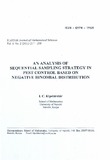| dc.contributor.author | Kipchirchir, I. C | |
| dc.date.accessioned | 2013-06-14T12:26:02Z | |
| dc.date.available | 2013-06-14T12:26:02Z | |
| dc.date.issued | 2011 | |
| dc.identifier.citation | Kipchirchir, I. C. An Analysis Of Sequential Sampling Strategy In Pest Control Based On Negative Binomial DistributionICAsrOR Journal of Mathematical Sciences Vol. 5, No.2 (2011) 217 - 228 | en |
| dc.identifier.issn | -0974 - 195X | |
| dc.identifier.uri | http://hdl.handle.net/11295/33921 | |
| dc.description.abstract | In this paper, we analyse sequential sampling strategy based on the negative binomial distribution in the context of chemical pest control with reference to environmental pollution and food security. Type I error means not spraying the crops when it is not necessary and type error means not spraying the crops when it is necessary. The analysis demonstrated that keeping both probabilities of type I and II errors at possible minima provide better protection against wrong decisions, however, the sequential process requires more observations (large sample size) and more so at the state of profound indifference. On the other hand, if we want to spray when necessary, that is, when the infestation has reached economic threshold, we should keep probability of type error at a possible minimum and if we want to avoid unnecessary pollution of the environment, we should keep probability of type I error at a possible minimum and have better protection against wrong decisions in each case without taking more observations. | en |
| dc.language.iso | en | en |
| dc.publisher | University of Nairobi | en |
| dc.title | An Analysis Of Sequential Sampling Strategy In Pest Control Based On Negative Binomial Distribution | en |
| dc.type | Article | en |
| local.publisher | School of Mathematics University of Nairobi | en |

